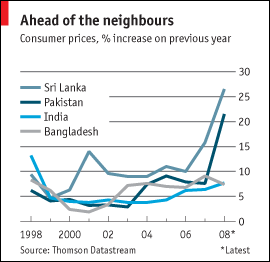Sri Lanka's Economic Troubles

It may not be any consolation to an average Pakistani but Pakistani economy is not alone in returning to the bad old days. Sri Lanka is keeping pace with Pakistan.
While Sri Lanka's long running civil war has largely been limited to the north and east, leaving the populous, well-off west largely unscathed, its stresses are beginning to show in the island nation's economy.
The Economist reports that Sri Lanka's annual inflation is close to 30%, the highest in South Asia. The rupee has appreciated against the dollar, further hurting exporters. By one estimate, economic growth—which was 7.6% in 2006—will be 4.3% this year. As elsewhere, inflation is being driven by high food and energy prices. But in Sri Lanka, 25-year average annual inflation is 12%. Monetary policy has been too loose, in part to finance the war. Including the cost of resettling refugees, the war eats up around 30% of the government’s budget.

Sri Lanka's exports and economy have been propped up by special EU preferences for Sri Lankan textiles. Under a concession known as “GSP Plus”, awarded in 2005 to help Sri Lanka rebuild after the 2004 tsunami, Sri Lankan exporters enjoy preferential tariff treatment from the EU. As a result, the EU is Sri Lanka ’s biggest export market, accounting for annual sales of around $1 billion; about half are covered by GSP Plus. But there is a problem with the rules of GSP Plus. Beneficiaries must comply with 27 international conventions, on environmental, labour and human rights standards. And on the last of these, Sri Lanka is struggling. The agreement expires at the end of 2008. The Economist believes that it will not be renewed.
What has upset the EU are various reports indicating government complicity in the abduction or murder of hundreds of Tamil and Muslim men. It is at war with human-rights groups. It has refused to let the UN High Commissioner for Human Rights set up an office in Sri Lanka. The EU cancellation of Sri Lankan preferences would mean 4% cut in Sri Lanka’s garment exports. Overall, it would cost 2% of GDP. If the EU renewed the agreement without progress on human rights, it might be challenged at the World Trade Organization—as happened to an EU trade sop to Pakistan in 2004.



Comments
COLOMBO, Sri Lanka -- China’s ambassador to Sri Lanka said Monday it is considering a request for $2.5 billion in assistance to help the island nation through a debt and foreign currency crisis.
Qi Zhenhong told reporters that Beijing is studying the Sri Lankan government’s appeal for a $1 billion loan and $1.5 billion credit line.
Sri Lanka needs to make nearly $7 billion in payments on foreign loans this year, but Qi was non-committal about a request to restructure China’s loans to Sri Lanka.
“Our ultimate goal is to solve the problem, but there may be different ways to do so,” he said.
Sri Lanka’s foreign reserves are dwindling at a time when it faces huge debt obligations. The country’s struggle to pay for imports has caused shortages of medicine, fuel, milk powder, cooking gas and other essentials, with people waiting in long queues to get fuel.
Residents are enduring daily power cuts due to a shortage of fuel to operate the generating plants and dry weather has sapped hydropower capacity.
The Central Bank allowed the local currency to free float earlier this month, causing a sharp increase in prices.
Sri Lanka’s economy depends heavily on tourism and trade and the pandemic has been disastrous, with the government estimating a loss of $14 billion over the last two years. The economy is estimated to have contracted by 1.5 % in July- September 2021, according to the central bank.
Sri Lanka's foreign reserves are shrinking partly because of construction projects built with Chinese loans that are not making money. China loaned the country money to build a seaport and airport in the southern Hambantota district and a wide network of roads.
Central Bank figures show that current Chinese loans to Sri Lanka total around $3.38 billion, not including loans to state-owned businesses, which are accounted for separately and thought to be substantial.
Qi said that since the outbreak of COVID-19 in 2020, China has provided $2.8b in financial help to Sri Lanka.
“Our aim is to help Sri Lanka to overcome the current difficulties,” he said.
Last week, neighboring India extended a $1 billion credit line to Sri Lanka to be used for importing food, medicines and other essentials from India.
The two Asian giants are vying for influence in the Indian Ocean and consider Sri Lanka strategically important.